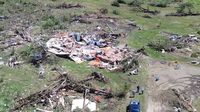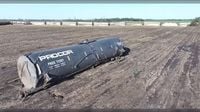For the first time in more than a decade, the United States has witnessed the raw, devastating power of an EF5 tornado. On June 20, 2025, a monstrous twister tore across the prairies near Enderlin, North Dakota, leaving a trail of destruction and heartbreak in its wake. The National Weather Service in Grand Forks confirmed this week that the tornado, which killed three people and obliterated everything in its path, reached the highest classification on the Enhanced Fujita (EF) scale, with wind speeds topping 210 mph (338 kph).
EF5 tornadoes are a rare breed. According to the National Oceanic and Atmospheric Administration’s Storm Prediction Center, only 60 such storms have been recorded since 1950. The last time the nation experienced an EF5 was in 2013, when a tornado ravaged Moore, Oklahoma, killing 24 people and injuring hundreds. This 12-year gap marks the longest EF5 drought since records began in 1950, and the Enderlin storm’s arrival has reignited conversations among meteorologists and storm scientists about tornado trends and the challenges of rating these catastrophic events.
The June 20 tornado first touched down near Enderlin, a small town about 40 miles southwest of Fargo. Over the course of nearly 20 minutes, it carved a 12-mile (19-kilometer) path northward, ending near the community of Alice. At its widest, the tornado measured 1.05 miles across—a monstrous funnel that left behind scenes of utter devastation. Aerial images taken the following day showed the remains of homes reduced to rubble, with only basements and scattered debris marking where buildings once stood, as reported by WDAY.
Among the casualties were two men and a woman, killed at two separate locations east of Enderlin. The city itself, according to Mayor Deon Maasjo, was largely spared apart from power outages, but the rural areas suffered catastrophic losses. Thousands of homes lost electricity, and the landscape was transformed: trees were uprooted or snapped down to stubs, transmission towers toppled, and farmsteads erased from the map. In one particularly haunting example, a farmstead’s foundation was swept clean, leaving only the basement behind, as described by the Grand Forks Herald.
Determining the strength of a tornado is a painstaking process, one that can take days, weeks, or even months. Meteorologists from the National Weather Service’s Grand Forks office ventured into the field the morning after the storm, surveying the damage with a critical eye. The EF scale, adopted in 2007 to replace the older Fujita scale, bases tornado ratings on the damage inflicted on buildings, trees, and infrastructure, with an added emphasis on structural integrity. The initial estimate for the Enderlin tornado was an EF3, but as the investigation continued, it became clear that something extraordinary had occurred.
"In the last kind of 12 years, there’s been several strong tornadoes that have come close, but there haven’t been known damage indicators at that time to support the EF5 rating," said Melinda Beerends, meteorologist in charge at the National Weather Service in Grand Forks, as quoted by the Associated Press. "It’s hard sometimes to get tornadoes to hit something."
This time, however, the tornado left behind unmistakable evidence. The most compelling clue came from the destruction of a freight train: one empty train car was lofted nearly 500 feet off the track, while several fully loaded grain hopper cars were tipped over. Engineers and wind damage experts were brought in to analyze this unusual damage, and their forensic surveys confirmed that only winds of EF5 strength could have caused such feats. As CNN noted, without the presence of the train cars, determining the tornado’s true magnitude might have been impossible, since the EF scale relies solely on damage indicators.
The science behind tornado formation is complex, and the Enderlin tornado was no exception. According to Beerends, the storm was born from a potent mix of warm, moist air and high wind shear—a variation in wind speed and direction that can spin up tornadoes when conditions are just right. This recipe is well-known to meteorologists, but the precise ingredients that produce an EF5 remain elusive. As Victor Gensini, a professor of atmospheric sciences at Northern Illinois University, pointed out to the Associated Press, tornado patterns have been shifting in recent decades, with more frequent outbreaks occurring east of the Mississippi River and closer to densely populated areas.
So, what explains the long EF5 drought? Some scientists argue that the answer lies not in the weather itself, but in the way tornadoes are rated. A recent study published in August suggested that the lack of EF5 ratings in recent years may be due to an imbalanced damage scale rather than an absence of powerful storms. Before 2007, the original Fujita scale defined F5 tornadoes as those with winds between 268 and 315 mph, but the Enhanced Fujita scale lowered the threshold to winds over 200 mph and added considerations for the quality of construction and structural integrity. As a result, many tornadoes that would have been rated F5 under the old system are now classified as EF4 unless there’s clear evidence—like a train car hurled hundreds of feet—that proves otherwise.
"It’s hard sometimes to get tornadoes to hit something," Beerends reiterated, highlighting the challenge of finding reliable damage indicators in sparsely populated rural areas. In the case of the Enderlin tornado, the presence of the train cars provided the crucial evidence needed to break the drought and reset the EF5 counter.
The rarity of EF5 tornadoes is both a blessing and a curse. While their infrequency means fewer communities are subjected to their unimaginable force, it also makes it harder for scientists to study and understand these storms. Each EF5 event becomes a case study in itself, prompting new questions about tornado genesis, rating systems, and the evolving risks posed by severe weather in a changing climate.
For the residents of Enderlin and the families of those lost, the scars of June 20, 2025, will linger long after the headlines fade. But for meteorologists and storm researchers, this tornado serves as a stark reminder: nature’s most violent winds can strike when least expected, and our understanding of them is always a work in progress.

